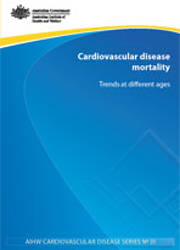Summary
This report looks at recent mortality trends over time in cardiovascular disease (CVD) and its main component diseases, across different age and sex groups.
Death rates for total CVD and each of its component diseases: coronary heart disease (CHD), stroke, heart failure/cardiomyopathy, rheumatic fever and rheumatic heart disease all fell between 1987 and 2006.
The main contributors to the overall trend for CVD are CHD and stroke, which have both shown substantial annual falls over the 20 years to 2006.
The annual decline in death rates for heart failure/cardiomyopathy has been accelerating.
The annual decline in rheumatic fever and rheumatic heart disease has been smaller than for CHD and stroke.
For CHD and stroke mortality:
- recent declines have been greatest among people aged 55-74 years
- the average annual rate of decline has accelerated among older people (65 years and over)
- the rate of decline for CHD has slowed among younger people (aged 35-54 years)
- the rate of decline for stroke has slowed among younger women (aged 35-54 years).
Despite the falls observed, death rates from CHD remain higher than those in many other developed countries, indicating the potential for further declines. The situation is similar for stroke.
For the Australian population as a whole, there have been:
- favourable trends in smoking rates and blood pressure levels
- little evidence of national change in blood cholesterol levels
- unfavourable trends in physical inactivity, obesity, and diabetes prevalence.
It is not possible to say how these trends have combined to affect the overall risk of CVD for Australians.
Improvements in medical care and treatment have also contributed to the declines in death rates from CHD and stroke.
The ageing of Australia's population, combined with the observed acceleration of the rate of decline in CHD and stroke death rates among older people, will lead to increased numbers of older Australians in coming years. This has important implications for the allocation of resources for preventative, medical and care services.
Preliminary material: Acknowledgments; Abbreviations
Introduction
- Background
- Aims
- Methods
Trends in all cardiovascular disease
- What are cardiovascular diseases?
- Deaths from cardiovascular disease
Trends in coronary heart disease
- What is coronary heart disease?
- Deaths from coronary heart disease
Trends in stroke
- What is stroke?
- Deaths from stroke
Trends in heart failure/cardiomyopathy
- What is heart failure/cardiomyopathy?
- Deaths from heart failure/cardiomyopathy
Trends in rheumatic fever and rheumatic heart disease
- What are rheumatic fever and rheumatic heart disease?
- Deaths from rheumatic fever and rheumatic heart disease
Trends in key risk factors
- Age
- Tobacco smoking
- Physical inactivity
- High blood pressure
- High blood cholesterol
- Overweight and obesity
- Diabetes
- Summary of risk factor trends
International trends
Comment and discussion
- Data sources and classifications
- Statistical methods
- Statistical tables
End matter: Glossary; References; List of tables; List of figures



